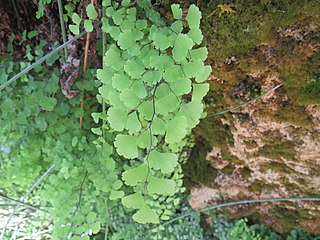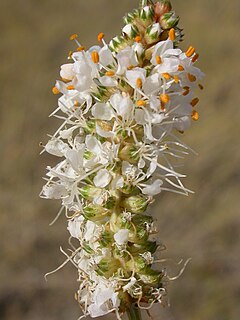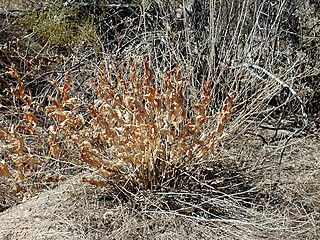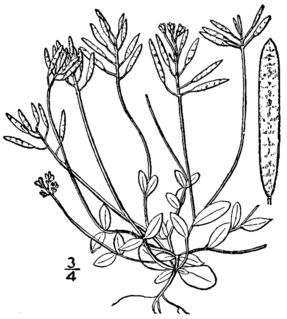See also Zuni ethnobotany, and Native American ethnobotany.
Contents
This is a list of plants utilized in Navajo culture.
See also Zuni ethnobotany, and Native American ethnobotany.
This is a list of plants utilized in Navajo culture.

Adiantum capillus-veneris, the Southern maidenhair fern, black maidenhair fern, maidenhair fern, and venus hair fern, is a species of ferns in the genus Adiantum and the family Pteridaceae with a subcosmopolitan worldwide distribution. It is cultivated as a popular garden fern and houseplant.

Abies balsamea or balsam fir is a North American fir, native to most of eastern and central Canada and the northeastern United States.

Acer glabrum is a species of maple native to western North America, from southeastern Alaska, British Columbia and western Alberta, east to western Nebraska, and south through Washington, Oregon, Idaho, Montana and Colorado to California, Arizona and New Mexico.

Baccharis salicifolia is a blooming shrub native to the sage scrub community and desert southwest of the United States and northern Mexico, as well as parts of South America. Its usual common name is mule fat; it is also called seepwillow or water-wally. This is a large bush with sticky foliage which bears plentiful small, fuzzy, pink or red-tinged white flowers which are highly attractive to butterflies. The long pointed leaves may be toothed and contain three lengthwise veins. It is most common near water sources.

Lithospermum incisum is a species of flowering plant in the borage family known by several common names, including fringed puccoon, narrowleaf stoneseed, fringed gromwell, narrowleaf puccoon, and plains stoneseed. It is native to much of central Canada and the United States, where it is known from many types of habitat, but particularly piñon-juniper woodlad. It is a hairy perennial herb growing from a taproot and woody caudex. It produces a cluster of stems up to about 30 centimeters long. The stems are lined with narrow, pointed leaves up to 6 centimeters long. The slender, trumpet-shaped flowers are pale to bright yellow or gold, and may approach 4 centimeters long. The corolla face is 1 to 2 centimeters wide, its lobes sometimes ruffled. The smaller cleistogamous (closed) flowers are the main producers of seed.
Abronia fragrans, the sweet sand-verbena, snowball sand-verbena, prairie snowball or fragrant verbena, is a species of sand verbena.

Viola nephrophylla syn. Viola nephrophylla Greene f. albinea (Farw.), Viola pratincola Greene, Viola retusa Greene ) is an annual or perennial forb in the Violet family (Violaceae) native to North America.

Dalea candida is a species of flowering plant in the legume family known by the common name white prairie clover. It is native to North America, where it can be found throughout central Canada, the central United States, and northern Mexico. It can sometimes be found outside its range as an introduced species. It grows in many types of habitat, including several types of prairie, foothills, woods, forests, and disturbed areas.

Commelina dianthifolia, known as the birdbill dayflower, is a perennial herb native to the south-western United States and northern Mexico. Petals are blue while sepals are green. The inflorescence is a scorpioid cyme and it is subtended by a boat-like spathe.

Fendlera rupicola, commonly known as the cliff fendlerbush or the false mockorange, is a shrub that grows in dry locations in the south central mountain regions of North America.

Psilostrophe tagetina is a flowering plant in the daisy family known by the common name woolly paperflower. It is native to Arizona, Colorado, Kansas, New Mexico, Oklahoma, Texas, Utah, and northwestern Mexico.
This is a list of plants used by the indigenous people of North America. For lists pertaining specifically to the Cherokee, Iroquois, Navajo, and Zuni, see Cherokee ethnobotany, Iroquois ethnobotany, Navajo ethnobotany, and Zuni ethnobotany.

Acourtia wrightii, common name brownfoot, is a North American species of plants in the sunflower family. It is native to the southwestern United States and northern Mexico.
This is a list of plants and how they are used in Zuni culture.
Agastache pallidiflora, commonly known as New Mexico giant hyssop or Bill Williams Mountain giant hyssop, is a plant in the mint family. It is used by the Ramah Navajo as a ceremonial chant lotion, for bad coughs, and the dried, pulverized root used as dusting powder for sores or cankers. The Ramah also use it a fumigant for "deer infection", as a febrifuge, and to protect from witches.

Symphyotrichum falcatum is a species of flowering plant in the family Asteraceae. Commonly called white prairie aster and western heath aster, it is native to a widespread area of central and western North America.

Arceuthobium vaginatum, called the "sheathed dwarf mistletoe" or "southwestern dwarf mistletoe" is a parasitic plant found in the southwestern United States and northwestern and central Mexico. It generally is found on pine trees.
This is a list of plants documented to have been traditionally used by the Cherokee, and how they are used.

Draba reptans, common names Carolina draba, Carolina whitlow-grass, Creeping whitlow-grass, and Whitlow-grass, is an annual plant in the family Brassicaceae that is native to North America.
The Iroquois use a wide variety of medicinal plants, including quinine, chamomile, ipecac, and a form of penicillin.